HP w2408: A "New" Twist on 24" LCDs
by Jarred Walton on December 21, 2007 5:00 AM EST- Posted in
- Displays
Printing
Results
Brightness and Contrast Ratio
For those who have a need to match colors between their computer displays, cameras, and printers, what works well for computing purposes often isn't the best suited for doing other image related work. To help people who work in such areas match their computer colors to their paper colors better, standards were established. For print work, the standard is a gamma of 2.2, a black point of 0.60 nits, and a white point of 100 nits. We attempt to calibrate all the monitors for these settings.
Finding the appropriate settings to reach these levels can be a time-consuming process for some of the displays. It may require numerous iterations through the calibration process to end up with the desired white point, and on some LCDs it might not even be possible to reach a satisfactory result (though that hasn't occurred yet). The nature of LCDs is such that we are unable to get both an accurate white point and an accurate black point according to printing requirements (our black levels always ended up darker than they are supposed to be), but we did manage to get near the desired 100 nits white point on all of the tested displays. We used brightness/contrast settings of 42/80 on the w2408, with RGB at 169/162/175.
For reference, we have included the target value in the following graphs, so the greater the deviance of a display from the targeted value, the less suitable (in theory) a display becomes for print work.
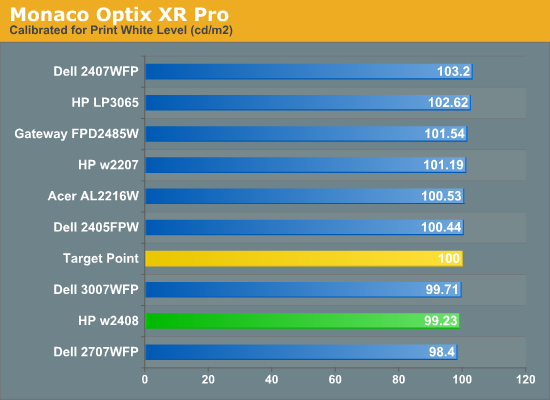
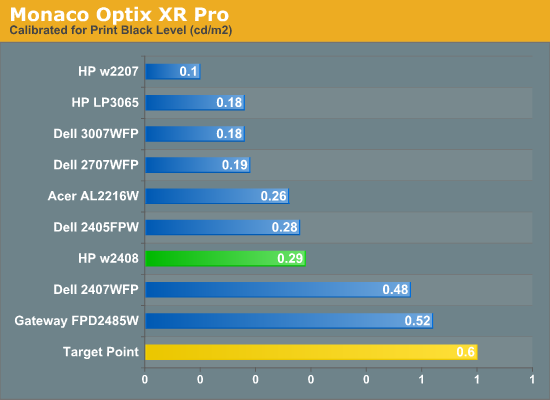
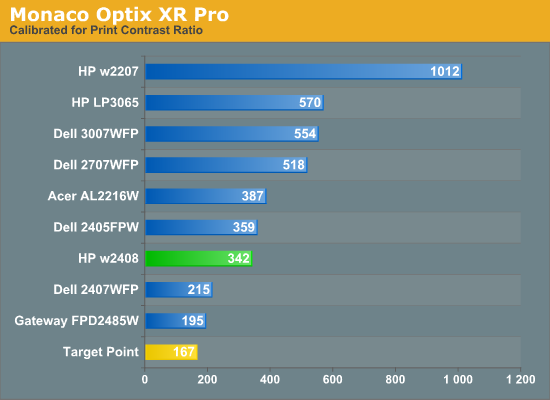
Since very slight differences in brightness are not a huge deal, we did not attempt to get 100% accuracy on the white point, but further tuning of the various displays would have made it possible to get closer to 100 nits. The primary goal was to get the white point near 100 nits. The target black point is nearly impossible to achieve once we have reached the target white point with any LCD that we have used. Due to the reduced brightness, contrast ratios are often lower, but that is inherent with the target settings. Interesting to note, we get higher black levels on many of the 24" LCDs than on other options when attempting to calibrate for print. The HP w2408 ranks third in terms of closeness to the print ideal.
Color Accuracy
Given the importance of accurate colors for printing work, we need to adjust the desired Delta E scale. A Delta E of less than 1.0 is definitely the goal here, and 1.0 to 2.0 is merely acceptable. Scores above 2.0 generally mean a display is not fit for printing professionals.
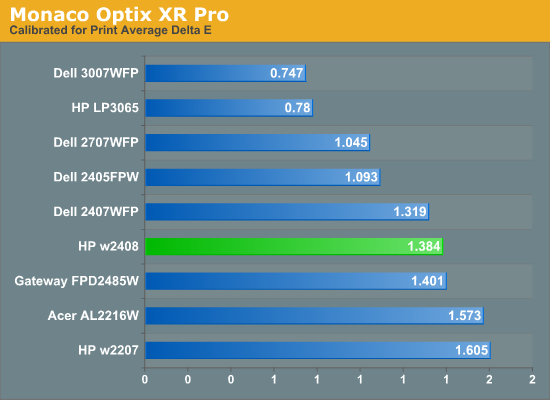
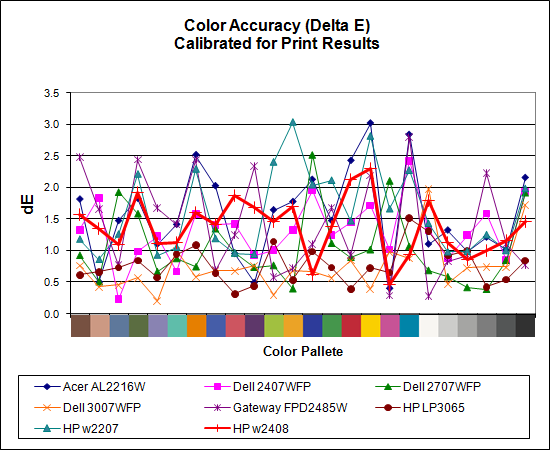
The two 30" displays clearly take the lead in this test, while the w2408 falls in the middle of the pack. Most of the scores fall below 2.0, which is better than the w2207. If you want 100/0.60 white/black settings for print work, this is one of the better options, though the Gateway FPD2485w and Dell 2407WFP still rated better.










30 Comments
View All Comments
wagaduku - Sunday, November 9, 2008 - link
Hi people i have read reviews of the following LCD's HP W2408,Acer G24 and Asus MK24. I cant seem to find which is the best of all.My main uses would PC games, Movies and internet browsing. Please guys i am to order one of the by tuesday.. Please Helpbolwin1 - Monday, January 14, 2008 - link
I research purchases pretty hard - and I've been trying to figure out what display to buy for quite some time. I've read every article and comparison I could get my eyes on.In the end, I wanted a monitor - not a tv or blu-ray display my Sony LCD can take care of that. I settled on the Soyo DYLM24D6 for $300 at OfficeMax. It is outstanding. A non-TN 24" display with NO backlight bleed for $380 out the door with a very good OfficeMax two year warranty. I realize they have had some production issues with some - but this thing is perfect and with the OfficeMax policy, if there is something wrong, take it back and they hand you another - for a value screen it cannot be beaten.
wagoo - Sunday, January 6, 2008 - link
I was researching into LCDs a bit recently, and figured that they had come down in price a lot since I bought my Dell 2005FPW so it might be time to pickup a cheap secondary 20", or a 24".I couldn't believe the slew of TN panels on the market these days. It seems like monitors with equivalent LCDs to the S-IPS panel in the Dell haven't come down in price at all, just the budget market has been filled in with inferior display technology.
Looking at the viewing angle on my laptop (which I'm guessing is TN), I couldn't see any way I'd be happy with that as a main or secondary monitor. I guess with the laptop I must subconsciously adjust the orientation and pitch so it looks alright.. doubt that would work with a large monitor. Sideways tilted viewing like this HP offers would also give a bit of an odd effect, as both eyes would be seeing different brightnesses.
More LCD reviews from AT would definitely be welcome! 32" 1080p TVs reviewed purely as a monitor would also be interesting.. some offer a "game mode" which may eliminate the picture processing latencies mentioned?
vailr - Wednesday, December 26, 2007 - link
Is there any significance to the "08" vs. "07" (in the HP monitor model numbers)?The w2207 is only available in a glossy surface.
I think I'd prefer a matte anti-glare finish monitor.
Also: are there any rumors Apple monitors being updated for faster response times? Thanks.
JarredWalton - Wednesday, December 26, 2007 - link
Don't know about Apple, but Dell is supposed to be coming out with a bunch of new models. I'd assume the w2207 vs. w2408 is a case of the w2408 being a bit newer - maybe some minor updates to firmware? Anyway, these two HP displays are glossy, and I definitely understand that a lot of people prefer matte - I know I do. I've got another 24" I'm working on reviewing next which should be more in the realm of what I think a 24" LCD should offer.Cerb - Monday, December 24, 2007 - link
I like my w2207, and use the portrait mode (rotating issues with the cables are easy to prevent once you do it a few times). But, the viewing angle becomes a bit of an issue, even then. I just can't imagine a 24" being worth it, using such a panel, at any price. At this size, it's begging for a *VA, even if it means being a $700 monitor.gochichi - Monday, December 24, 2007 - link
On quality:It really is too bad that for the most part LCDs are getting cheaper at the expense of quality these days. I recently purchased a 24" Acer that was on sale for under $300.00 and I took it back the next day. My archaic 17" LCD was WAY better overall than that.
On the issue of review units: (Comment/question for AT)
Are you somehow not permitted to buy your own test units? So many companies have lavish return policies, what would be the big deal? I'm thinking Best Buy, Circuit City etc. You know, the places we're still most likely to get a monitor from.
I think very highly of Anandtech, and I guess I imagine it being an extremely profitable site. I hope I'm not wrong there. In any case, it seems very strange to me to have such a prestigious site at the whim of manufacturers.
I could not for the life of me find a review on said 24" Acer, and the only thing it did was make me buy it and return it. If not full reviews, perhaps AT could concatenate a list of which monitors use what kind of panel and some expert "at a glance" comments.
I am kind of baffled by new LCDs on the market, I'm not too impressed so far actually. I use a 24" LG that is now $450 at best buy and it seems to me to be a fantastic deal at that price.
complectus - Sunday, December 23, 2007 - link
All of the Color Accuracy (Delta E) graphs are an utter mess. Can anyone actually read them without going blind?SoBizarre - Sunday, December 23, 2007 - link
I believe you should drop monitor reviews. Reviewing a couple of monitors a year (not even belonging to "desirable" category) is not very helpful to your readers.The truth is, there’s not even one site out there serious about reviewing costumer-grade monitors, and the main reason for that situation is the one you have mentioned yourself: manufacturers don’t send their products to reviewers.
And why is that? I suspect most of them have too much to hide.
I would love to find on AnandTech a 24 inchers shoot-out broke into two categories: cheap TN panels and more expensive IPS & PVA. Shoot-out of 22 inchers would be useful to even greater number of readers. And why not a quick take on several wide screen 20 inchers...
You wouldn’t have to go too much in-depth in these reviews. Some basic tests and subjective evaluation of text, video and games usage would be enough. I bet people trust your ability to pick up a winner.
Now, in reality there is only one possibility for all these to happen. You need a big retailer to supply you with monitors. I’m sure it would be very beneficial for them, because they would have professional evaluation of products they’re carrying (they could stock more of highly rated monitors and sell them like hot rolls), and gain a positive reputation for helping their customers to choose the right product.
But maybe in IT world this kind of cooperation is just not possible for some reasons. I don’t know, why don’t you enlight us?
SoBizarre - Sunday, December 23, 2007 - link
Something else I forgot to say:MERRY WINTER SOLSTICE and a HAPPY NEW YEAR!